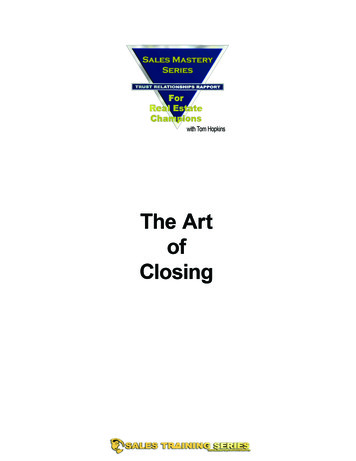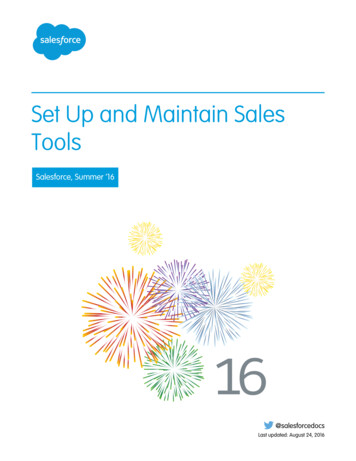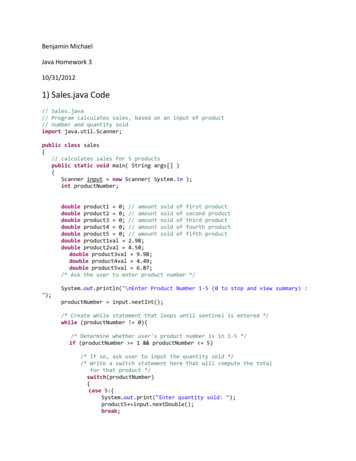
Transcription
The Art of ClosingNOTESLength – 22:31 minutesClosing defined: Professionally using a person’s desire toown the benefits of your product. Then, blending yoursincere desire to serve in helping a person make a decisionthat’s truly .What Really Happens When You Close theSale?1.You help clients a decisionthey want to make.2.You help clients head off .3.You help clients deal with their .4.You help clients overcome .Buying Signs To Watch ForVerbal –Visual –Building Real Estate ChampionsCopyright 2006 Tom Hopkins International, Inc.1
NOTESThe Final Closing SequenceThe final closing sequence begins one of three ways:1.The buyer asks you a question.Use these seven words to move onto the form: “Letme make a note of that.”2.You ask them a question. This is aquestion that tests whether or not they’re ready togo ahead.John, how are you feeling about all of this so far?John and Mary, do you see why I’m so excitedabout this property?3.You ask them a question to move ontothe paperwork.1.2.3.If they stop you, warmly say, I know you’re not completelysure of the decision to go ahead. However, it’s been proventhat a good decision is only as good as the facts, so itmakes sense that I outline all the facts so we can carefullyweigh everything and at that point make the right decision,okay?When you finish filling out your paperwork, pick it up,scan it for accuracy, and deliver your final closingsentence.John, with your approval right here, we’ll set up theclosing in 30 days.Critical Instruction: Whenever you ask the final closingquestion, !Building Real Estate ChampionsCopyright 2006 Tom Hopkins International, Inc.2
Increasing Your Sales EffectivenessMany of us have one sales message. Because it's successful with some of our prospects, weoverlook the fact that our single message falls flat with many others.Let's suppose that your basic presentation takes about fifteen minutes. Of course, you vary itslightly to fit each prospect's situation but, basically, you give the same presentation in the same wayto everyone. The style that you always use might be described as brisk, businesslike, and pleasant.You've chosen a style that's effective between 30 and 60% of the time. (Effective in the sensethat it'll allow you to make the sale if everything else is right.) Now let's go after the other 40 to 70%who are turned off by brisk, businesslike, and pleasant types with their shiny shoes and cheerfulsmiles.Design and practice three variations on every aspect of your selling sequence. You may bevarying your approach to some degree now, but you'll enormously increase your ability to fit yourwords and actions to each prospect if you'll consciously work at creating triple-headed responses.Let me explain further. I'm recommending that you practice three ways of phrasing every goodanswer that you have to each objection. One phrasing might be slangy or homespun, another mightbe lofty or long-worded, and one-should be clearly stated in standard English.The triad concept doesn't stop here. Each of those three phrasings of the single answer can besaid fast, at medium speed, or slowly. You can speak softly, in normal tones, or loudly. Your attitudecan be respectful, friendly, or assertive. That's 81 variations on a single answer to an objection. (3 x 3x 3 x 3 81) When you apply this idea to every aspect of your selling sequence, you'll quicklydevelop such a huge inventory of responses that finding the perfect fit for every prospect will be easy.(Perfect in the sense that if there's any way the sale can be made you'll make it.)PRESENTATIONSStart with your basic presentation and devise three variations. Here's one set of possibilities:1.) Casual, relaxed and alert.2.) Brisk, businesslike and pleasant.3.) Intense, candid and personal.DELIVERYDevelop three moods of delivery:1.) Light. You can be easy without being careless and you can be funny without getting hookedon it. I've known salespeople who would rather get a laugh than make a sale. Do some of yourlaughing on the way to the bank by using humor in sales situations to further sales, not to amuseyourself.If humor isn't your forte now, don't worry--it'll come in time. Meanwhile, cultivate a relaxedapproach that will ease you into closing position with the more informal of your prospects who can'tstand the all-business attitude.2.) Medium. A cordial, alert, matter-of-fact stance gives you the safest start with old customerswho have volatile temperaments and with future clients you don't know yet.3.) Heavy. Be prepared to talk fast and concisely in high pressure situations. Nothing works wellhere except bone and muscle delivered in short, crisp sentences. No jokes, no flowery phrases, noconfusing technicalities. Practice this one hard and you'll be surprised how often you'll use it, anddelighted how often you'll win with it.Do this and you can't fail to multiply your effectiveness, reduce your frustrations, and expand yourincome.Here's the triad concept. It sounds complex but it isn't. All you have to do is train yourself to thinkin terms of three:--three routes to every treasure,--three solutions for every challenge,--three chances at every opportunity.Copyright 2005 Tom Hopkins International, Inc.Excerpted from Tom’s book, Mastering the Art of Selling Real Estate, Portfolio Books, 2004.Building Real Estate ChampionsCopyright 2006 Tom Hopkins International, Inc.3
B U IL DIN G R EA L E ST A T EC H A M PIO N Swith Tom HopkinsThe Art of ProspectingAd call phraseologyBuyer FearsDo what you fear mostFalling in love with no formulaGetting caller’s namesGetting phone numbersHold buttonItch cycleManager letterNewspaperNot giving out an addressOrphan adoptionWhy people buyWhy people don’t buyThe Art of Original ContactBuilding rapportCaller’s names, gettingDefense barriersDressFeasibleFirst names, permissionFlexibleFor Sale By OwnersGet down to business statementListingSellingPermissionto use first namesto take notesQualifyingRemembering namesVoice mailThe Art of QuestioningAlternate of choiceInverted tie downInvolvementListeners, typesPorcupineTie downWhy we askThe Art of Addressing ConcernsConcernsAddressingSix stepsConditionsThe Art of ClosingBuyVerbal signsVisual signsClosingDefinedStrategiesLet me make a note of thatReflex questionTest questionsPowerful Closing StrategiesBuyers remorseFact-weighing scaleI want to think it overIt costs too muchLost saleOblique comparisonReduction to ridiculousSecondary questionSimilar situationThink it overKeeping a Positive AttitudeAttitudes toward failureChampion creed
The Art of Questioning Alternate of choice Inverted tie down Involvement Listeners, types Porcupine Tie down Why we ask The Art of Addressing Concerns Concerns Addressing Six steps Conditions The Art of Closing Buy Verbal signs Visual signs Closing Defined Strategies Let me make a note of










